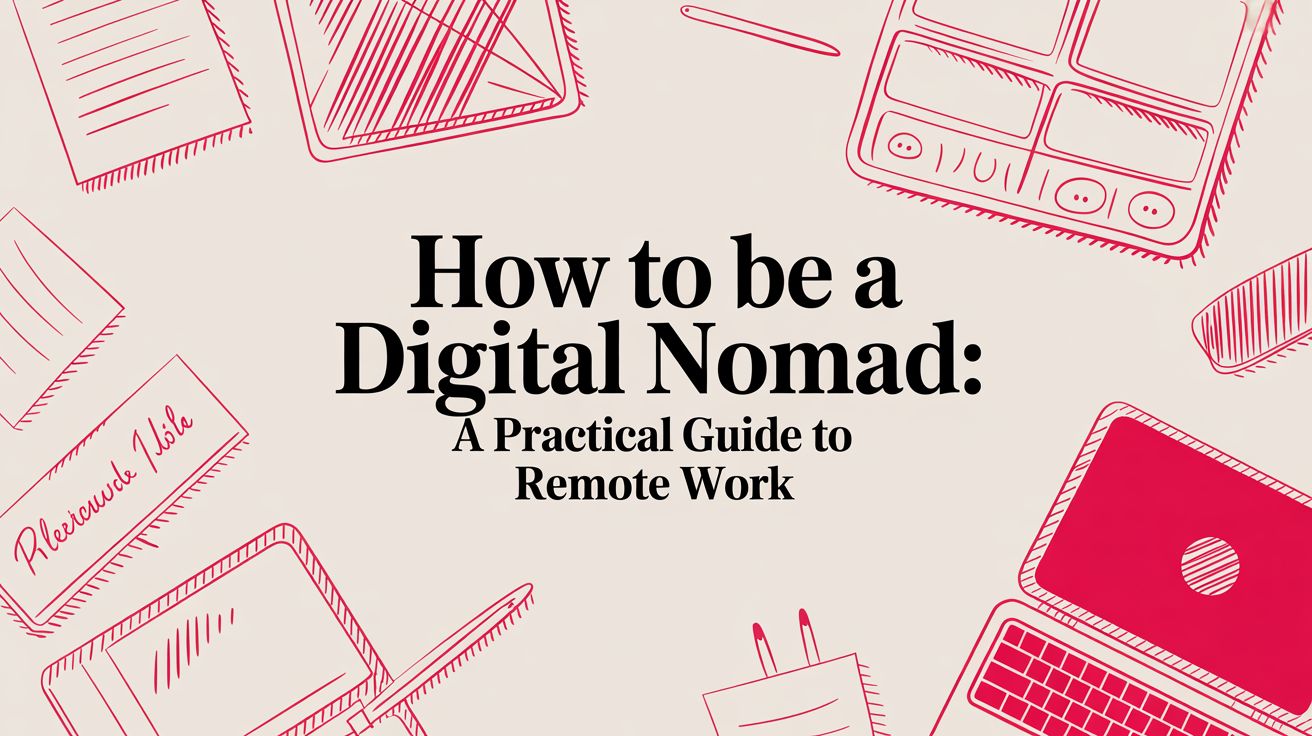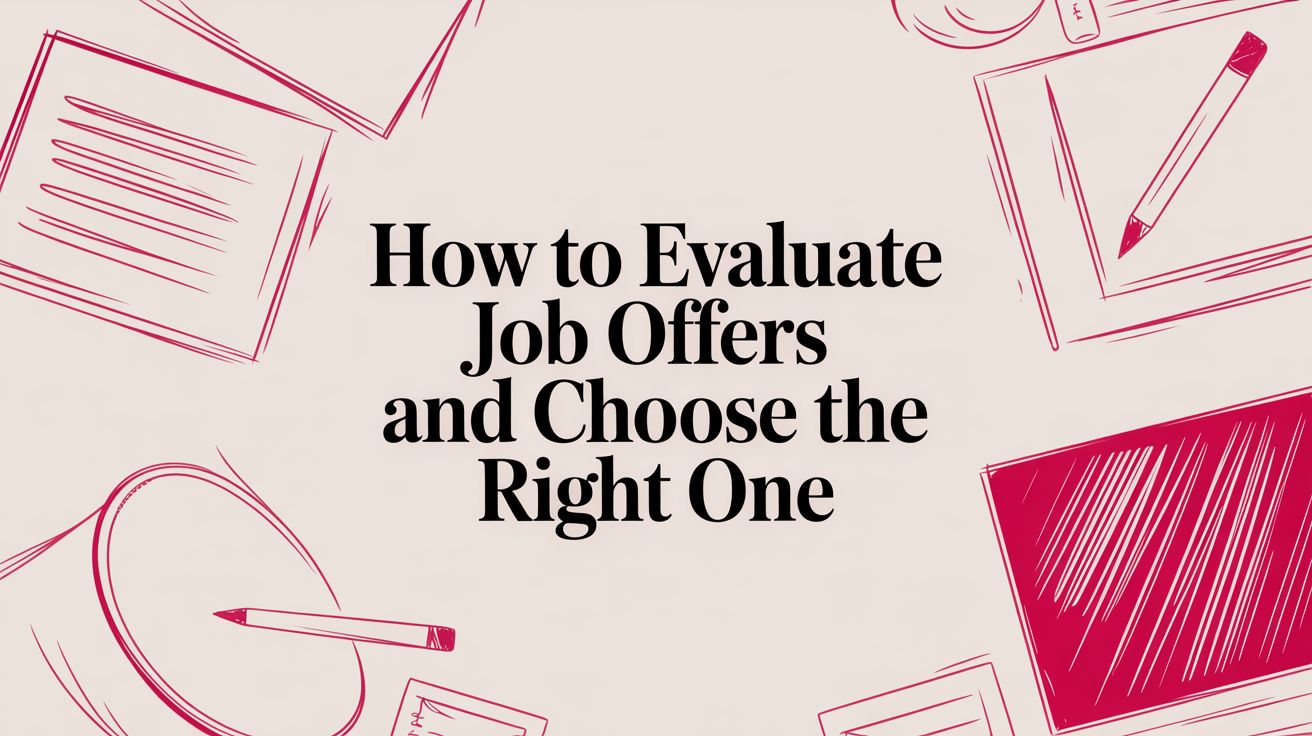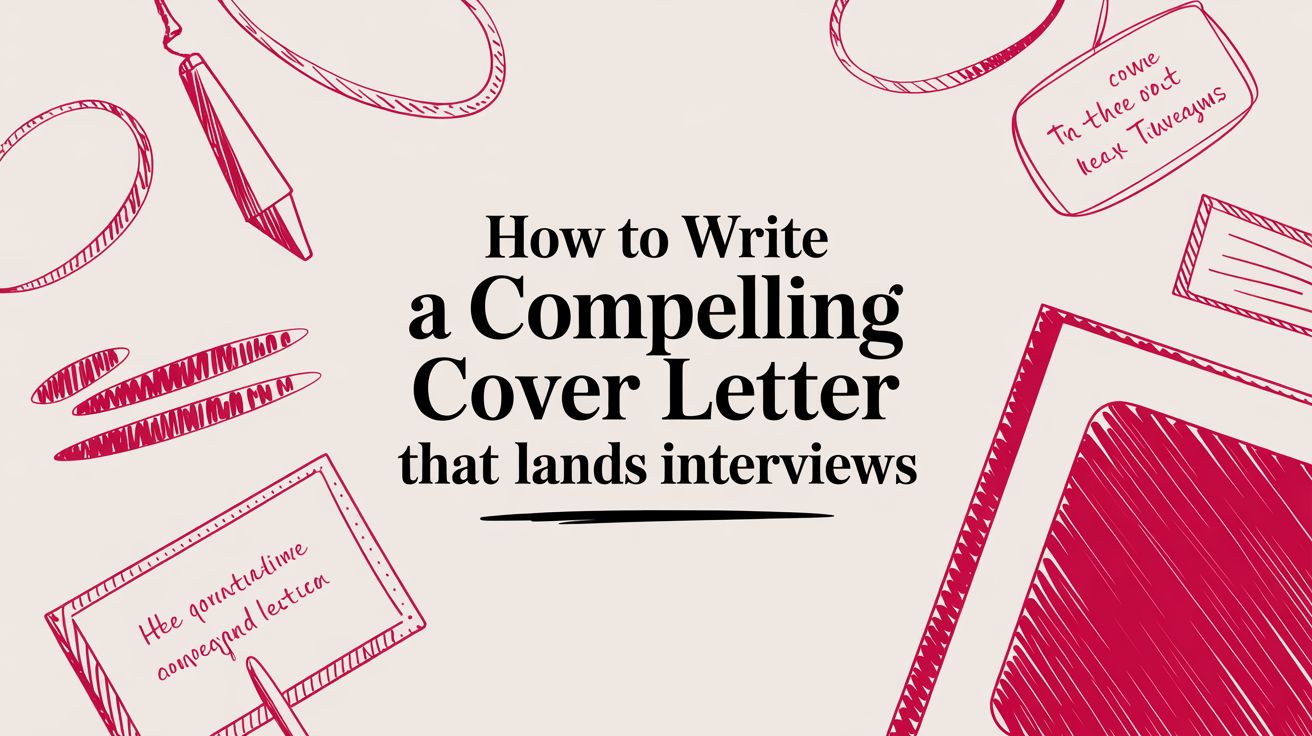Professional Resume Help to Secure Your Next Remote Job
Max
In a cut-throat job market, where a recruiter might only glance at your resume for a few seconds, getting professional resume help can be the one thing that gets you noticed. It’s the difference between having a simple work history and a powerful marketing tool that’s built to impress both automated systems and the humans behind them.
Why Your Resume Needs A Professional Edge

Think of your resume less as a historical record and more as your personal sales pitch. It’s your one shot. When a single remote job post attracts hundreds of applicants from all over the world, a bland, generic resume just won’t cut it. It’s going to get lost in the shuffle.
Honestly, the difference between landing an interview and being ignored often comes down to strategy, storytelling, and just plain good presentation. This is where an expert eye makes all the difference.
A professional resume writer knows exactly how to frame your experience to spotlight real, measurable achievements, instead of just listing off your daily duties. They also get the nuances of Applicant Tracking Systems (ATS) and can structure your resume to sail right through those digital gatekeepers.
Moving Beyond A Simple Job List
One of the biggest mistakes I see is people treating their resume like a laundry list of past jobs. “Managed social media accounts” is a task. It’s boring.
Now, “Grew social media engagement by 45% in six months by implementing a new content strategy”—that’s an achievement. See the difference? That’s the kind of shift in thinking that gets you hired.
Professional help gets you there by:
- Pinpointing and quantifying your accomplishments, even in jobs that don’t seem driven by numbers.
- Swapping out tired phrases for powerful action verbs that scream leadership and initiative.
- Weaving your experience into a compelling narrative that tells a hiring manager who you are and what you can bring to their team.
This strategic approach isn’t just a nice-to-have anymore; it’s essential. The market for professional resume help is expected to jump from $1.5 billion in 2025 to over $3 billion by 2033, with an annual growth rate of around 8%. That’s a lot of people realizing they need an edge.
Key Insight: Your resume isn’t just about what you did. It’s about proving the value you can bring to a new company. A professional touch makes sure that value is communicated loud and clear.
How Professional Help Transforms Key Resume Sections
See how a professional approach can completely reframe the standard sections of your resume? It’s about turning every line into an opportunity.
| Resume Section | A Standard Approach | A Professional Approach |
|---|---|---|
| Summary | “Experienced professional seeking a new opportunity.” | “Results-driven marketer with 8+ years of experience, specializing in boosting user acquisition by over 30% through data-backed SEO strategies.” |
| Experience | “Responsible for managing project budgets.” | “Managed a $500K project budget, delivering the final project 15% under budget by optimizing vendor contracts and resource allocation.” |
| Skills | Lists generic skills like “Communication” and “Teamwork.” | Integrates specific, in-demand skills like “Agile Project Management,” “Salesforce CRM,” and “Python” directly into achievement-based bullet points. |
This table shows it clearly: the goal is to be specific, impactful, and strategic.
Adapting To Global And Remote Markets
The explosion of remote work has thrown the doors wide open—which means the competition is fiercer than ever. You’re not just up against local candidates anymore; you’re competing with talent from around the globe.
This global stage demands a resume that’s universally understood and professionally polished. If you’re eyeing jobs in specific international markets, for example, mastering the CV format for that region is a non-negotiable part of looking professional.
It’s no secret why everyone wants these roles; our guide on the https://remotefirstjobs.com/blog/remote-work-benefits-transforming-2025-opportunities shows just how life-changing they can be. A top-tier resume is your ticket in. It sends a clear signal to employers: you’re a serious candidate who invests in your own career. When you treat your resume like the critical asset it is, you’re setting yourself up for success, no matter the market.
Getting Your Resume Past the Digital Gatekeepers
Before a real person ever lays eyes on your resume, it almost always has to get past a digital gatekeeper first. I’m talking about the Applicant Tracking System, or ATS. Its entire job is to scan, sort, and rank the flood of resumes companies receive. In fact, an estimated 99% of Fortune 500 companies now rely on an ATS.
This is the hidden reason why so many perfectly qualified people get that dreaded rejection email—or just silence. If your resume isn’t formatted in a way the machine can easily read, it gets tossed into the digital void before a hiring manager even knows you exist. But don’t worry. Once you understand how these systems work, you can actually make them work for you.
A huge part of this is mastering the strategies to beat Applicant Tracking Systems, which really just means you need to think like the machine. It isn’t looking for a creative masterpiece; it’s looking for clarity, specific keywords, and a standard, predictable format.
Decoding the ATS Language
The best way to think of an ATS is like a very literal, no-nonsense librarian. It can’t appreciate fancy graphics, custom fonts, or clever layouts. It just parses text, looking for specific information in the places it expects to find it. Anything that gets in the way of that simple process can cause your resume to be misread or, worse, completely discarded.
For instance, any text you place in the header or footer of your document might as well be invisible. The same goes for complex tables. Columns are another classic mistake—the ATS often reads straight across, turning your carefully organized sections into an incomprehensible jumble of words.
To make sure your resume is machine-readable, keep it clean and simple. Stick with standard, universally recognized fonts like Arial, Calibri, or Times New Roman. When it comes to the file type, your safest bet is almost always a .docx or a .pdf, as long as the PDF is text-based and not just a flat image of your text.
Keywords Are Your Key to Entry
Beyond just the formatting, the ATS is programmed to hunt for specific keywords and phrases that align with the job description. This is probably the single biggest opportunity that applicants miss. A generic, one-size-fits-all resume just won’t have the precise language the system is looking for.
Your mission, then, is to mirror the language of the employer. Go through the job posting with a fine-tooth comb and pull out the core skills, qualifications, and responsibilities they mention.
- Hard Skills: Look for specific software (like Salesforce or Adobe Creative Suite), programming languages (like Python or Java), or key certifications (PMP, Google Analytics).
- Soft Skills: Do you see recurring phrases like “project management,” “cross-functional collaboration,” or “stakeholder communication”? Note them down.
- Action Verbs: Pay close attention to the verbs they use to describe the role, such as “developed,” “managed,” “analyzed,” or “optimized.”
You need to weave these exact keywords naturally throughout your resume, especially in your work experience and skills sections. This is how you signal to the ATS that you’re a strong fit. For highly specialized roles, this alignment is non-negotiable. For example, when it comes to hiring remote software developers, you can bet the ATS is fine-tuned to find very specific technical terms that a generic resume would never include.
This image breaks down the kind of simple structure an ATS can easily understand.
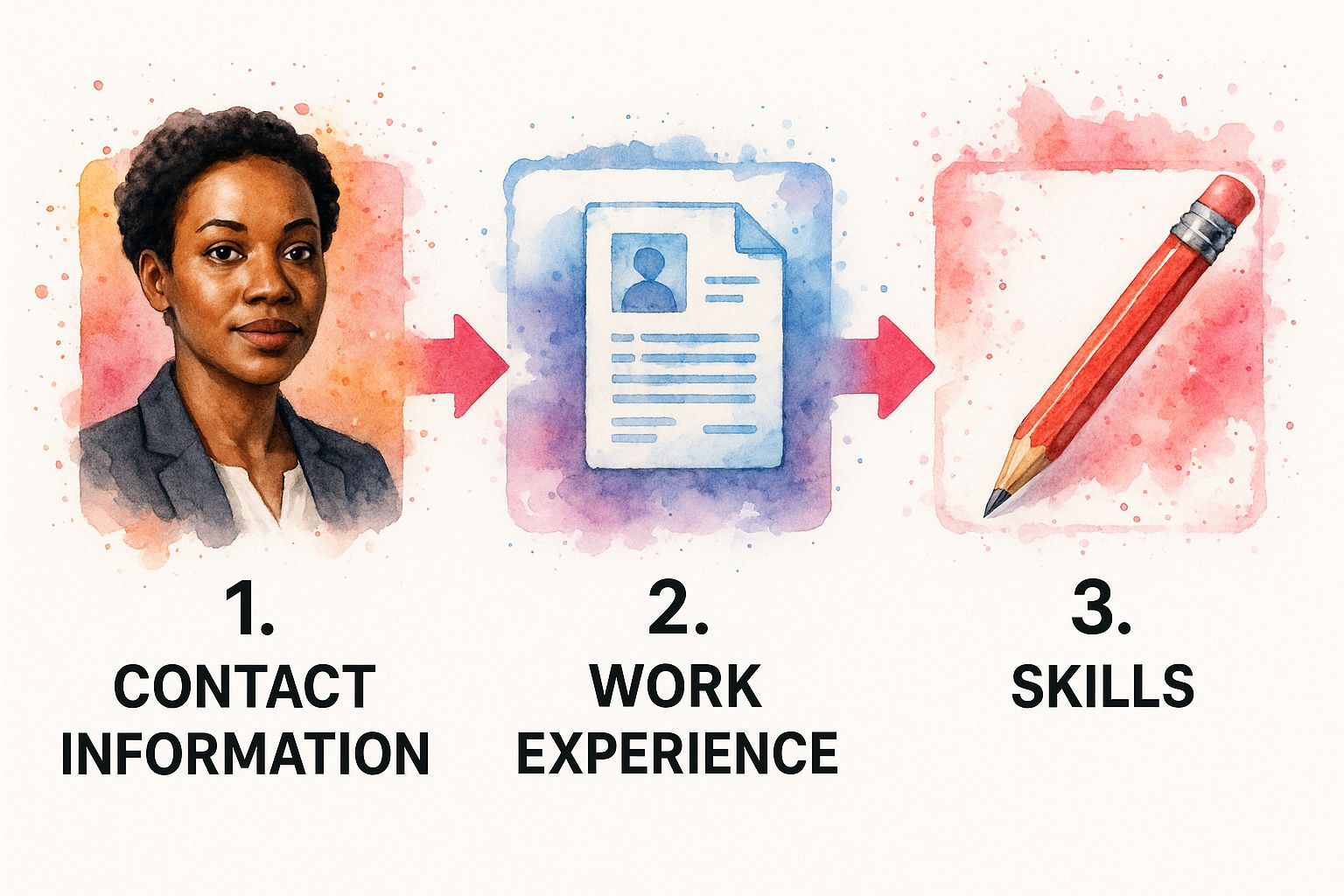
This straightforward, linear flow—from your contact info down to your work history and skills—presents your information in a logical order that the software can process without any errors.
Pro Tip: Don’t just cram keywords into a list at the bottom of your resume. The most effective method is to work them into your achievement-focused bullet points. For example, instead of just listing “SEO,” you could write: “Grew organic search traffic by 45% in six months by developing and executing targeted SEO strategies.”
By focusing on clean formatting and smart keyword integration, you’re essentially removing the technical roadblocks that stop your resume from getting seen. This ensures your application sails past that initial digital screening and lands right where it belongs: in the hands of a hiring manager who can see the real value you bring to the table.
Crafting a Summary That Grabs Attention

You have 7.4 seconds. That’s the average time a recruiter spends scanning your resume before making a snap judgment. In that tiny window, your professional summary is your single most important asset. It’s the first thing they see and your best shot at making them pause and read more.
This isn’t the place for an old-school “objective statement” that just talks about what you want. Think of your summary as the trailer for your career. It needs to be a short, powerful pitch that showcases the value you bring to the table. It has to be compelling enough to make someone want to see the whole movie.
Nailing this section is especially critical for remote jobs, where your ability to communicate your value quickly and clearly is a must-have skill. It’s about shifting your mindset from just listing job duties to highlighting your unique selling points.
The Anatomy of a Powerful Summary
So, what makes a summary truly effective? It’s a short narrative—just two to four sentences—that weaves together three core components. It should immediately answer the recruiter’s biggest question: “Why should I even consider this person?”
Let’s break it down.
- Who You Are: Start with a strong, descriptive title. “Senior Project Manager” is fine, but “Senior Project Manager with 10+ years of experience leading cross-functional tech teams” tells a much richer story.
- What You Do Best: Pinpoint 2-3 of your most impressive skills or specialties. Critically, these need to align with the keywords you see in the job description.
- Your Biggest Win: This is where you bring the proof. Include a measurable achievement that shows your skills in action and connects them to real business results.
This simple structure turns your summary from a passive description into an active demonstration of what you can do. It gives them immediate proof of your competence.
Examples of Effective Summaries
Theory is one thing, but seeing it in practice is another. Notice how each of these examples is tailored for a specific role and packed with quantifiable success.
For a Marketing Manager: “Data-driven Marketing Manager with 8+ years of experience specializing in B2B SaaS growth. Proven ability to develop and execute multi-channel campaigns that increased marketing-qualified leads by 60% in the last fiscal year. Expert in HubSpot, SEO, and content strategy.”
For a Software Developer: “Full-Stack Developer with a 5-year track record of building, testing, and deploying scalable web applications. Highly proficient in JavaScript (React, Node.js) and Python. Led the development of a new customer-facing feature that improved user retention by 15%.”
Key Takeaway: The best summaries are loaded with specifics. Vague claims like “results-oriented” or “team player” are resume killers. Use hard numbers and specific skills to show, not just tell, what you’re capable of.
Avoiding Common Summary Pitfalls
Knowing what not to do is just as important as knowing what to do. A few common mistakes can sink your resume before a recruiter even gets to your experience section.
The biggest blunder? Using the same generic summary for every single application. Customization is everything. If you’re serious about your job hunt, especially as you learn how to find remote work from home jobs in 2025, you absolutely have to tailor this section to each role.
Here are a few other traps to watch out for:
- Clichés and Buzzwords: Ditch the empty fluff. Phrases like “go-getter,” “think outside the box,” or “dynamic professional” are overused and tell the reader nothing.
- First-Person Pronouns: It might feel natural, but avoid using “I” or “my.” Sticking to the third person is the standard convention and sounds more professional on a resume.
- Making It Too Long: Keep it tight and punchy. Three to four lines is the sweet spot. Anything longer will likely get skipped over.
By focusing on a clear, customized, and achievement-driven summary, you create a powerful hook that grabs a recruiter’s attention and sets the stage for the rest of your resume.
Showcasing Your Impact, Not Just Your Duties
Let’s be honest, hiring managers are drowning in resumes that list job duties. They don’t just want to know what you were supposed to do; they want to see what you actually did and what difference it made.
The strongest resumes don’t just list responsibilities—they showcase results. This is probably the single biggest opportunity most job seekers miss. They play it safe, listing tasks, when they should be providing hard evidence of their value.
It’s the difference between “managed a team” and “mentored a team of five junior developers, boosting code deployment efficiency by 25% in one quarter.” The first is forgettable. The second is memorable, tangible, and gets you a call back. This shift from passive duty to active accomplishment is what separates a good resume from a great one.
It’s about telling a compelling story of your professional wins, with the receipts to back it up.
From Passive Duties To Active Accomplishments
It’s time to put every bullet point under your work experience on trial. Look at each one and ask yourself, “So what?” If your bullet point just describes a task you performed, it’s not pulling its weight. It needs to scream accomplishment.
Think about the “before and after” of your work. Did you save the company time? Cut costs? Drive revenue? Improve a process or boost customer satisfaction? These are the outcomes that make a recruiter stop scrolling and pay attention.
Even if your role wasn’t swimming in metrics, you can still frame your impact. Think about the projects you spearheaded, the positive feedback you consistently received, or the small efficiencies you introduced that made everyone’s life easier.
Introducing The STAR Method
A brilliant way to structure these accomplishments is the STAR method. It’s a simple, effective framework to ensure every bullet point tells a complete and persuasive story.
- Situation: Briefly describe the context or challenge.
- Task: What was your specific goal or responsibility in that situation?
- Action: What specific steps did you take to address it? Use strong, dynamic verbs.
- Result: What was the measurable outcome of your actions?
You don’t literally write “Situation,” “Task,” etc., on your resume. Instead, you artfully weave these elements into a single, powerful bullet point. This structure is what gives your experience section its knockout punch.
Expert Insight: The “Result” is the star of the show here. It’s the proof in the pudding. Whenever possible, lead with the result or make it the undeniable focus of the bullet point to grab immediate attention.
Before and After: Real-World Examples
Let’s see this transformation in action. Notice how the “after” examples are packed with specific numbers, metrics, and powerful verbs. They paint a vivid picture of success.
Example 1: Project Manager
- Before: Responsible for managing project timelines and communication.
- After: Orchestrated a $2M software implementation project, delivering it 3 weeks ahead of schedule by introducing an Agile methodology that improved team communication and cut rework by 40%.
Example 2: Customer Service Representative
- Before: Answered customer emails and phone calls.
- After: Resolved an average of 50+ customer inquiries daily, consistently maintaining a 98% customer satisfaction score and slashing ticket resolution time by 15%.
These “after” versions are what get you noticed. They don’t just state a function; they prove your effectiveness. This is a skill that becomes more crucial as your career progresses. Data shows that 50% of resumes are created by mid-level professionals with five to fifteen years of experience, a stark contrast to just 14% from those with less than five years. It’s clear that the more experience you have, the more critical it is to prove your impact. You can discover more insights about resume creation trends and see how professionals at different levels are tackling this.
By making this shift to an impact-first mindset, you transform your resume from a historical document into a forward-looking argument for why you’re the solution to their problem. You don’t just fill a role—you deliver results.
Tailoring Your Resume for Remote Opportunities
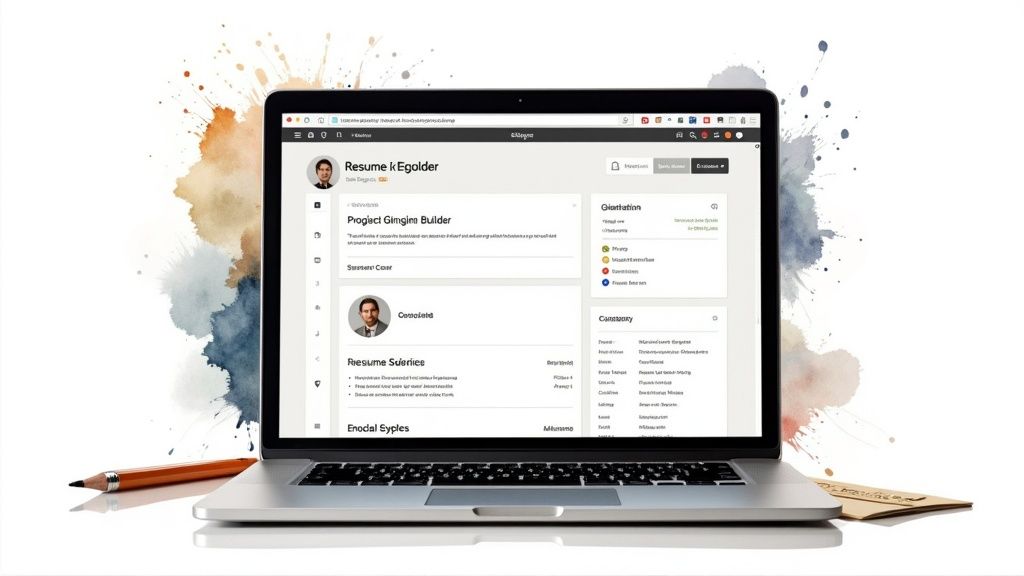
Think your standard resume will cut it for a remote job? Think again. Landing a top-tier remote role isn’t just about having the right experience. It’s about proving you can thrive without someone looking over your shoulder.
Hiring managers for remote positions are hunting for a specific breed of professional. They need people who are self-starters, masters of communication from afar, and disciplined enough to deliver great work from a home office. Your resume has to scream that you’re that person. They won’t connect the dots for you.
This is where a little strategy goes a long way. The talent pool for remote jobs is global, which means competition is fierce. Simply listing your job duties won’t be enough to stand out.
Highlighting Essential Remote Work Skills
Certain skills are the bread and butter of successful remote work, and they need to be more than just a footnote on your resume. We’re talking about the core competencies that truly remote-first companies build their teams around.
The trick is to weave these skills throughout your resume—not just in a dedicated “Skills” list, but baked directly into your work experience. That’s how you provide undeniable proof.
Here’s what you need to emphasize:
- Asynchronous Communication: Show you can keep projects humming along without back-to-back meetings. Talk about how you used tools like Slack or project management software to keep teams in sync across different time zones.
- Self-Discipline & Time Management: This is all about proving you’re a pro you can trust. Did you own your project pipeline? Consistently crush deadlines with little oversight? Put a number on it whenever you can.
- Tech Proficiency: Get specific. Don’t just say “proficient in collaboration software.” Name the actual tools you’ve mastered, like Slack, Asana, Jira, Trello, or Microsoft Teams.
For example, a generic bullet point just won’t do. Instead of “Responsible for content projects,” level it up: “Independently managed a 3-month content project using Asana for task tracking and Slack for asynchronous updates, delivering the final project one week ahead of schedule.” See the difference?
Pro Tip: Don’t forget your LinkedIn profile! It’s just as crucial as your resume. Make sure your headline, summary, and experience sections all echo the same remote-friendly skills and achievements. A consistent professional brand is a powerful thing.
Showcasing Your Ability to Work Autonomously
In the world of remote work, trust is everything. A hiring manager needs to feel confident that you’ll be just as productive and reliable from your couch as you would be in their office. Your resume is your first, and best, chance to build that trust.
Go through your work history and pinpoint every instance where you took the lead, worked independently, or managed a project with minimal supervision. Frame your accomplishments to highlight your initiative. This tells a hiring manager you’re a dependable professional who doesn’t require hand-holding.
This level of self-motivation is a non-negotiable for many of the top remote companies, which often build their entire culture on autonomy and personal ownership.
The intense competition for these roles has fueled a huge demand for resume help. As more people seek remote work, candidates are looking for any edge they can get to stand out in a global talent pool. You can discover more insights about the resume writing market to see just how much these work trends are shaping hiring.
By carefully fine-tuning your resume, you send a clear signal: you don’t just want a remote job, you’re built for one. This strategic move could be the very thing that lands you your next great opportunity.
Common Questions About Improving Your Resume
Even when you follow all the best advice for crafting a standout resume, little questions can pop up and cause a surprising amount of stress. It’s one thing to understand the big-picture strategy, but it’s the smaller details that often leave job seekers feeling stuck.
Let’s clear up that confusion. Here are some of the most common—and pressing—questions people have when they’re trying to get their resume just right. I’ll give you direct, no-nonsense answers so you can finalize your resume with confidence and start applying for that next great remote role.
How Long Should My Resume Be?
This is easily one of the most debated topics in the resume world. For decades, the rule was simple: one page, no exceptions. While that’s still fantastic advice for many, the modern job market—especially for remote work where deep experience is a huge plus—allows for a bit more flexibility.
Here’s a practical way to think about it:
- Less than 10 years of experience: Stick to one page. Be ruthless. Your goal is to be concise and focus on impact, cutting anything that isn’t directly relevant to the job you want. Brevity forces you to highlight only your most impressive wins.
- More than 10-15 years of experience: A two-page resume is perfectly fine and often necessary. This is especially true for senior-level professionals, executives, or specialists in fields like science or academia who have extensive projects, patents, or publications to list.
- Never three pages: Unless you’re a high-level academic with a massive list of published works, a three-page resume is almost always a mistake. It sends a signal that you can’t prioritize information, which isn’t a quality hiring managers are looking for.
Ultimately, it’s about relevance, not just length. A cluttered, hard-to-read single page is far less effective than a clean, well-organized two-page document that tells a clear story of your career.
Should I Use a Creative or Visual Resume?
It’s tempting, I get it. A creative resume with cool layouts, colors, and graphics feels like a great way to stand out from a pile of plain black-and-white documents. But honestly, this is a high-risk, low-reward move for most people.
The biggest problem is the Applicant Tracking System (ATS). These bots are designed to read standard, text-based formats. When they encounter complex designs, columns, or graphics, they get confused. The result? Your application might be misread or tossed out before a human ever sees it.
Key Insight: For the vast majority of roles, especially in corporate sectors like tech, finance, and operations, a clean, professional, and traditionally formatted resume is your safest—and most effective—bet. Let your achievements be what makes you stand out, not your font choice.
Of course, there are exceptions. If you’re a graphic designer, UI/UX specialist, or work in another highly visual field, a creative resume can act as a mini-portfolio. Even then, it’s a smart move to have an ATS-friendly, plain-text version ready to go for online applications.
How Far Back Should My Work Experience Go?
Another point of confusion is just how much of your work history to include. You definitely don’t need to list every job you’ve had since you were a teenager. In fact, doing that can clutter your resume and even inadvertently date you.
A good rule of thumb is to focus on the last 10 to 15 years of relevant experience. This gives employers a comprehensive look at your recent career path without overwhelming them with ancient history.
Experience older than 15 years can usually be condensed or removed entirely. The only exception is if an older role is uniquely and powerfully relevant to the job you’re targeting. For instance, if you’re a Senior Marketing Director now, your first part-time retail job probably isn’t adding value. But if an early job gave you foundational experience with a niche technology that’s critical for your target role, you could list it in a brief, separate section like “Previous Professional Experience.”
Is a Cover Letter Still Necessary?
Yes. Absolutely. While some online applications might list it as “optional,” skipping the cover letter is a massive missed opportunity. A recent survey found that 83% of hiring managers said a great cover letter could persuade them to interview a candidate, even if their resume wasn’t a perfect match.
Think of it this way: your resume shows what you’ve done. Your cover letter explains why you are the right person for this specific job at this specific company. It’s your chance to:
- Show genuine excitement for the role and the company.
- Connect your biggest wins directly to the company’s needs.
- Explain potential questions in your background, like a career gap.
- Let your personality and communication skills shine through.
A generic, copy-paste cover letter is a waste of everyone’s time. But a thoughtful one, tailored to the role? That can be the very thing that gets you the interview.
A strong application is just the first step, of course. You’ll also want to review these 8 essential remote interview tips to master in 2025 to make sure you’re ready for what comes next.
Ready to stop guessing and start applying with confidence? At Remote First Jobs, we connect talented professionals like you with thousands of verified remote opportunities. Find your next remote job today!
